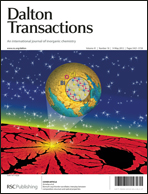Treatment of [Pt{4′-(Ph)trpy}Cl]SbF6 with AgSCN in a metathesis reaction in refluxing acetonitrile affords, after work-up, single crystals of [Pt{4′-(Ph)trpy}(NCS)]SbF6·CH3CN, where trpy is 2,2′:6′,2′′-terpyridine. These crystals lose solvent to give single crystals of [Pt{4′-(Ph)trpy}(NCS)]SbF6 (1). An X-ray crystal structure determination of 1 shows that the SCN− ion is N-bound and that the cation as a whole is approximately planar. Compound 1 is porous with “empty” channels that corkscrew through the crystal: this crystal structure is stabilised by extended π–π interactions between the planar cations. When a single crystal of 1 is exposed to vapours of acetonitrile the vapours are sorbed without loss of single crystallinity, as confirmed by crystal structure determinations of 1 and 1·CH333CN using the same single crystal. Similarly, single crystals of 1 sorb vapours of methanol without loss of single crystallinity, as confirmed by a crystal structure determination of 1·CH33OH. We also report the crystal structure of 1·(CH33)22CO; however, in this case the single crystal was grown directly from acetone. Compound 1 and its solvates are all yellow. Nevertheless, there are differences between the emission spectra recorded for 1 and its solvates in the solid state. Thus, whereas 1 exhibits very weak multiple emission from 3MLCT (MLCT = metal-to-ligand charge transfer) and excimeric 3π–π* excited states, 1·CH333CN and 1·(CH33)22CO both exhibit more intense 3MLCT emission; and the emission by 1·CH33OH is complicated by the presence of metallophilic interactions in the crystal. We discuss the role of the solvent in causing these differences.
![Graphical abstract: Sorption of small molecule vapours by single crystals of [Pt{4′-(Ph)trpy}(NCS)]SbF6 where trpy = 2,2′:6′,2′′-terpyridine: a porous material with a structure stabilised by extended π–π interactions](/en/Image/Get?imageInfo.ImageType=GA&imageInfo.ImageIdentifier.ManuscriptID=C2DT12398C&imageInfo.ImageIdentifier.Year=2012)
You have access to this article
 Please wait while we load your content...
Something went wrong. Try again?
Please wait while we load your content...
Something went wrong. Try again?
![Graphical abstract: Sorption of small molecule vapours by single crystals of [Pt{4′-(Ph)trpy}(NCS)]SbF6 where trpy = 2,2′:6′,2′′-terpyridine: a porous material with a structure stabilised by extended π–π interactions](/en/Image/Get?imageInfo.ImageType=GA&imageInfo.ImageIdentifier.ManuscriptID=C2DT12398C&imageInfo.ImageIdentifier.Year=2012)

 Please wait while we load your content...
Please wait while we load your content...